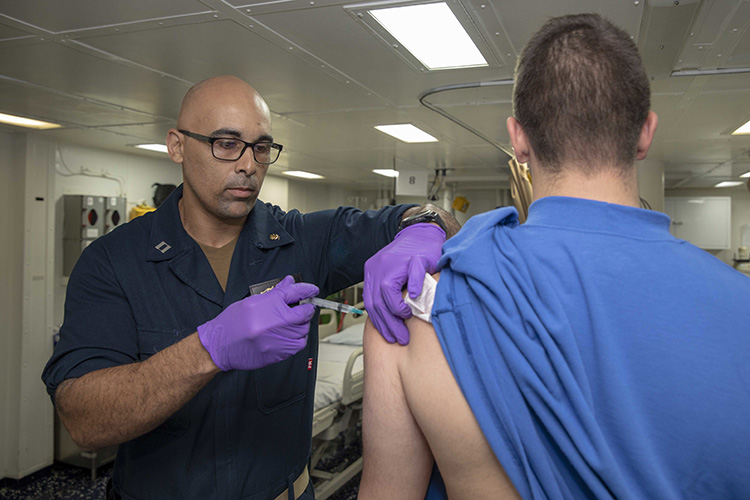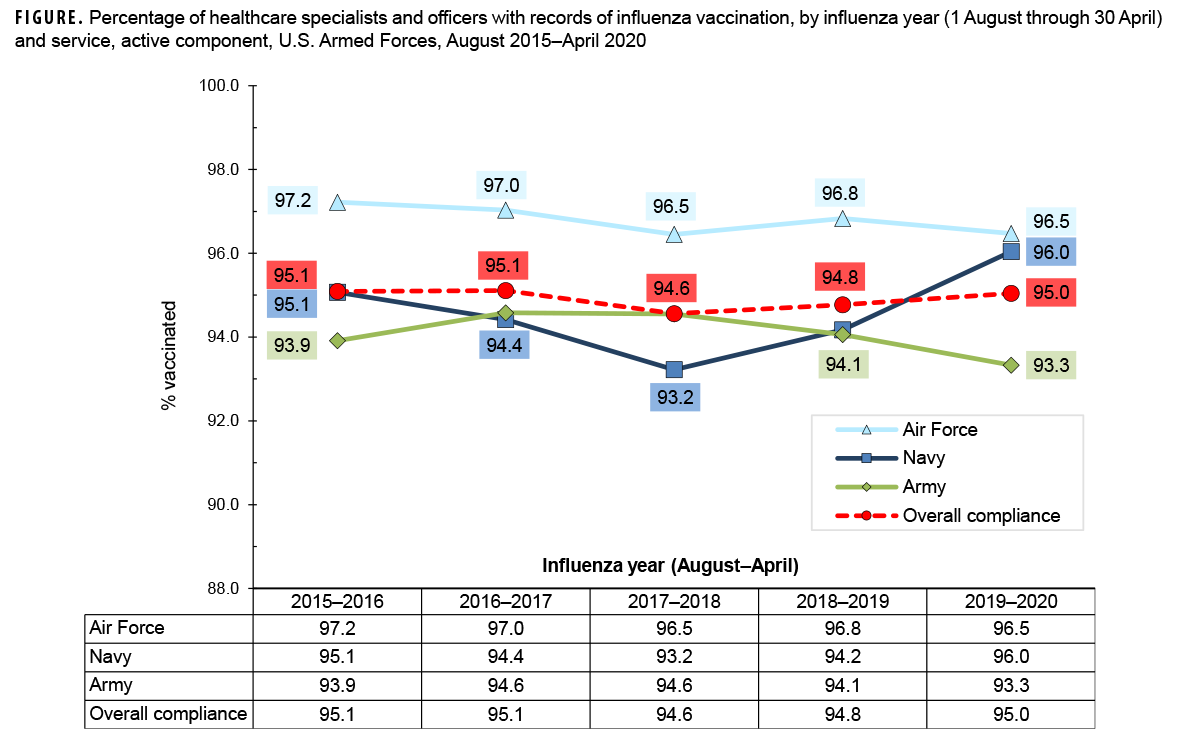Surveillance Snapshot: Influenza Immunization Among U.S. Armed Forces Healthcare Workers, August 2015–April 2020
 NORFOLK (Oct. 15, 2019) Lt. Sipriano Marte administers an influenza vaccination to Airman Tyler French in the intensive care unit aboard the Wasp-class amphibious assault ship USS Kearsarge (LHD 3). Kearsarge is underway conducting routine training. (U.S. Navy photo by Mass Communication Specialist Petty Officer 3rd Class Jacob Vermeulen/Released)
NORFOLK (Oct. 15, 2019) Lt. Sipriano Marte administers an influenza vaccination to Airman Tyler French in the intensive care unit aboard the Wasp-class amphibious assault ship USS Kearsarge (LHD 3). Kearsarge is underway conducting routine training. (U.S. Navy photo by Mass Communication Specialist Petty Officer 3rd Class Jacob Vermeulen/Released)
10/1/2020
By:
Armed Forces Health Surveillance Branch Communications Team
The U.S. Advisory Committee on Immunization Practices recommends that all healthcare personnel be vaccinated against influenza to protect themselves and their patients.1 The Joint Commission’s standard on infection control emphasizes that individuals who are your infected with influenza virus are contagious to others before any signs or symptoms appear. The Joint Commission requires that healthcare organizations have influenza vaccination programs for practitioners and staff and that they work toward the goal of 90% receipt of influenza vaccine. Within the Department of Defense, seasonal influenza immunization is mandatory for all uniformed personnel and for healthcare personnel who provide direct patient care and is recommended for all others (excluding those who are medically exempt).2–4
This snapshot covers a 5-year surveillance period (August 2015–April 2020) and presents the documented percentage compliance with the influenza immunization requirement among active component healthcare personnel of the Army, Navy, and Air Force. During the 2019–2020 influenza season, each of the 3 services had compliance rates of 93.3% or higher among healthcare personnel (Figure). For all services together, the compliance rate was 95.0%, very similar to the rate from the previous year.
References
-
Centers for Disease Control and Prevention. Immunization of health-care personnel: recommendations of the Advisory Committee on Immunization Practices (ACIP). MMWR Recomm Rep. 2011;60(RR-7):1–45.
-
Headquarters, Departments of the Army, the Navy, the Air Force, and the Coast Guard. Army Regulation 40-562, BUMEDINST 6230.15B, AFI 48-110_IP, CG COMDTINST M6230.4G. Medical Services: Immunizations and Chemoprophylaxis for the Prevention of Infectious Diseases. 7 October 2013.
-
Assistant Secretary of Defense (Health Affairs). Policy for Mandatory Seasonal Influenza Immunization for Civilian Health Care Personnel Who Provide Direct Patient Care in Department of Defense Military Treatment Facilities. Health Affairs Policy 08-005. 4 April 2008.
-
Assistant Secretary of Defense (Health Affairs). Addition of Pandemic Influenza Vaccine or Novel Influenza Vaccine to the Policy for Mandatory Seasonal Influenza Immunization for Civilian Health Care Personnel Who Provide Direct Patient Care in Department of Defense Military Treatment Facilities. Health Affairs Policy 11-010. 28 July 2011.

You also may be interested in...
Article
May 1, 2019
Among service members deployed during 2018, injury/poisoning, musculoskeletal diseases, and signs/symptoms accounted for more than half of the total health care burden while deployed. Compared to the distribution of major burden of disease categories documented in garrison, a relatively greater proportion of in-theater medical encounters due to ...
Article
May 1, 2019
In 2018, mental health disorders accounted for the largest proportions of the morbidity and healthcare burdens that affected the pediatric and younger adult beneficiary age groups. Among adults aged 45–64 years, musculoskeletal diseases accounted for the most morbidity and healthcare burdens, and among adults aged 65 years or older, cardiovascular ...
Article
May 1, 2019
As in prior years, mental health disorders, pregnancy-related conditions, and injury/poisoning accounted for the majority (59.8%) of all hospitalizations among active component service members in 2018. However, the hospitalization rate for all causes was the lowest rate in the past 10 years.
Article
May 1, 2019
In 2018, mental health disorders accounted for the largest proportions of the morbidity and healthcare burdens that affected the pediatric and younger adult beneficiary age groups. Among adults aged 45–64 years, musculoskeletal diseases accounted for the most morbidity and health care burdens, and among adults aged 65 years or older, cardiovascular ...
Article
Apr 1, 2019
Risk factors for heat illnesses (HIs) among new soldiers include exercise intensity, environmental conditions at the time of exercise, a high body mass index, and conducting initial entry training during hot and humid weather when recruits are not yet acclimated to physical exertion in heat. This study used data from the Defense Health Agency’s ...
Article
Apr 1, 2019
Among active component service members in 2018, there were 545 incident diagnoses of rhabdomyolysis likely due to exertional rhabdomyolysis, for an unadjusted incidence rate of 42.0 cases per 100,000 person-years. Subgroup-specific rates in 2018 were highest among males, those less than 20 years old, Asian/Pacific Islander service members, Marine ...
Article
Apr 1, 2019
In 2018, there were 578 incident diagnoses of heat stroke and 2,214 incident diagnoses of heat exhaustion among active component service members. The overall crude incidence rates of heat stroke and heat exhaustion diagnoses were 0.45 cases and 1.71 cases per 1,000 person-years, respectively. In 2018, subgroup-specific rates of incident heat stroke ...
Article
Apr 1, 2019
From 2003 through 2018, there were 1,579 incident diagnoses of exertional hyponatremia among active component service members, for a crude overall incidence rate of 7.2 cases per 100,000 person-years (p-yrs). Compared to their respective counterparts, females, those less than 20 years old, and recruit trainees had higher overall incidence rates of ...
Article
Apr 1, 2019
As the most frequently reported vector-borne disease among active component U.S. service members, with an incidence rate of 16 cases per 100,000 person-years in 2011, Lyme disease poses both a challenge to health care providers in the Military Health System and a threat to military readiness. Spread through the bite of an infected blacklegged tick, ...
Article
Mar 1, 2019
This report summarizes incidence rates of the 5 most common sexually transmitted infections (STIs) among active component service members of the U.S. Armed Forces during 2010–2018. Infections with chlamydia were the most common, followed in decreasing order of frequency by infections with genital human papillomavirus (HPV), gonorrhea, genital herpes ...
Article
Mar 1, 2019
During 2000–2017, a total of 170,878 active component service members underwent a first-occurring vasectomy, for a crude overall incidence rate of 8.6 cases per 1,000 person-years (p-yrs). Among the men who underwent incident vasectomy, 2.2% had another vasectomy performed during the surveillance period. Compared to their respective counterparts, the ...
Article
Mar 1, 2019
Infertility, defined as the inability to achieve a successful pregnancy after 1 year or more of unprotected sexual intercourse or therapeutic donor insemination, affects approximately 15% of all couples. Male infertility is diagnosed when, after testing both partners, reproductive problems have been found in the male. A male factor contributes in part ...
Article
Mar 1, 2019
This analysis summarizes the prevalence of testosterone replacement therapy (TRT) during 2017 among active component service men by demographic and military characteristics. This analysis also determines the percentage of those receiving TRT in 2017 who had an indication for receiving TRT using the 2018 American Urological Association (AUA) clinical ...
Article
Feb 1, 2019
Malaria infection remains an important health threat to U.S. service members who are located in endemic areas because of long-term duty assignments, participation in shorter-term contingency operations, or personal travel. In 2018, a total of 58 service members were diagnosed with or reported to have malaria. This represents a 65.7% increase from ...
Article
Feb 1, 2019
Glaucoma is an eye disease that involves progressive optic nerve damage and vision loss, leading to blindness if undetected or untreated. This report describes an analysis using the Defense Medical Surveillance System to identify all active component service members with an incident diagnosis of glaucoma during the period between 2013 and 2017. The ...
You are leaving Health.mil
The appearance of hyperlinks does not constitute endorsement by the Department of Defense of non-U.S. Government sites or the information, products, or services contained therein. Although the Defense Health Agency may or may not use these sites as additional distribution channels for Department of Defense information, it does not exercise editorial control over all of the information that you may find at these locations. Such links are provided consistent with the stated purpose of this website.
You are leaving Health.mil
View the external links disclaimer.
Last Updated: July 11, 2023